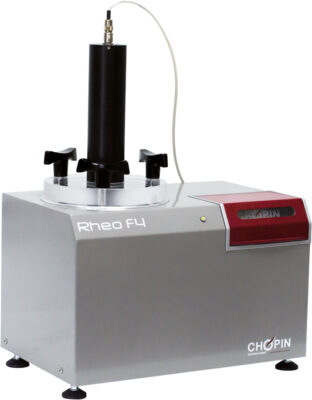
Yeast Performance Testing
Also known as yeast activity or gassing power
What is Yeast Performance Testing?
Yeast performance testing encompasses various procedures for determining the time required for dough to reach a certain volume, or the volume of dough at a given proof time. This can be evaluated using standardized procedures.
Yeast performance tests allow bakers to:
- Adjust yeast levels in dough for optimum volume
- Predict yeast performance during fermentation and proofing
- Adjust proofing/fermentation conditions like temperature or humidity
- Adjust formulation and evaluate the effects of sucrose, water and salt on yeast activity
- Evaluate the impact of freezing/thawing on yeast tolerance
- Detect excessive or insufficient levels of starch damage and/or α-amylase activity
How does it work?
Yeast performance tests assess the production of CO2 gas during the fermentation or proofing of a dough sample under standardized formulation, temperature and humidity conditions. The Cereals & Grains Association (AACC International) provides a method for assessing the activity (gas production) of yeast in dough. The method determines:
- Total or cumulative gas production during a fixed time at a controlled temperature, expressed in mL, or any other equivalent unit such as gauge pressure on a sealed container
- Gas production rate (mL of gas evolved per minute) at standard barometric pressure.
The method is applicable to the following yeast forms:
- Compressed yeast (CY) with approximately 30% solids
- Active dry yeast (ADY) with approximately 92% solids
- Instant dry yeast (IDY) with approximately 95% solids
Formulas containing 0, 8, and 20% sugar (based on flour weight) can be used for different tests. Dough formulations must be prepared so that equal weights of dough contain equal weights of yeast solids (0.70 g of yeast solids per 100 g of dough). The higher the sugar level, the lower the yeast activity.

Rheo F4 measures Yeast Performance. By KPM Analytics
Application
The yeast performance test using the AACCI Official Method 89-01.01 below is for compressed and active dry yeasts:1
- Pretreatment of yeast
- For CY: 5 min before mixing, weigh 0.01 g of compressed yeast, crumble it into a beaker and soak in distilled water at 70°F (21°C) for yeast rehydration. See formulas in the table below.
- For ADY: Warm yeast to room temperature for at least 30 min before use. Prepare 3% sugar solution with water for yeast rehydration (see formulas) in a beaker (rehydration water is 4–5 times the weight of yeast). Then, weigh 0.01 g of dry yeast and add to sugar solution with initial mild hand stirring. Rehydrate at 110°F (43°C) for 10 min with sufficient stirring to obtain a uniform suspension of yeast.
- Mixing of dough
- Weigh all dry ingredients except yeast and place into mixer bowl. Dough temperature is to be controlled at 86 ± 2°F (30 ± 1°C).
- Add yeast suspension to mixer bowl. Use the rest of water for dough hydration to rinse in yeast (see formulations). Mix dough in a pin mixer to full development and to 86 ± 2°F (30 ± 1°C).
- Give dough 5-min bench rest while measuring temperature.
- Determination of gas production
- Any instrument for measuring pressure or volume of gas evolved during dough fermentation can be used.
- Place dough piece (of proper size) into each chamber of gas-measuring device. Permit 5-min period for temperature equilibration. Then start gas measurement at 86 ± 2°F (30 ± 1°C). A water bath can be used to maintain constant dough temperature.
- Measure gas evolution over 90-min period.
- Report total volume of gas (evolved after 90 min) per hour. If pressure units are used, values must be converted to volume of gas at standard barometric pressure by using perfect gas laws.
Dough formulas for compressed and active dry yeast
| Ingredient | 0% Sugar | 8% Sugar | 20% Sugar | |||
| CY | ADY | CY | ADY | CY | ADY | |
| Bread flour | 100 | 100 | 100 | 100 | 100 | 100 |
| Sugar (sucrose, refined, crystallized) | – | – | 8 | 8 | 20 | 20 |
| Nonfat dry milk | – | – | 4 | 4 | 4 | 4 |
| Shortening | 3 | 3 | 3 | 3 | 3 | 3 |
| Salt | 2 | 2 | 2 | 2 | 2 | 2 |
| Water (distilled for yeast rehydration) | 25 | 6.25 | 25 | 6.25 | 25 | 6.25 |
| Water, remainder | 40 | 60 | 38.75 | 58.75 | 28.75 | 48.75 |
| Yeast, wet weight | 4.06 | 1.31 | 4.32 | 1.40 | 4.37 | 1.41 |
| Or, yeast solids | 1.218 | 1.205 | 1.296 | 1.288 | 1.310 | 1.297 |
| Total weight of dough (Baker’s %) | 174.06 | 172.56 | 185.07 | 183.40 | 187.12 | 185.41 |
| Weight of yeast solids/dough, % | 0.70 | 0.70 | 0.70 | 0.70 | 0.70 | 0.70 |
Instruments/equipment used for testing yeast performance
- Risograph
- YeastForce
- Fermentograph
- Maturograph
- Rheo F4
- Gasograph
Relevant considerations
- All formulations are based on 100 g of flour. However, amounts can be scaled up or down depending on the test needs. Formulas must always contain 0.70 g of yeast solids per 100 g of dough. This allows comparison of gassing power among different yeast types.
- Yeast performance and baking quality: Gas production and retention by the dough are directly related to the quality of the finished products. Loaf volume and crumb grain are dependent on yeast activity and gas retention in the gluten matrix.
References
- AACC International. Approved Methods of Analysis, 11th Ed. Method 89–01. Yeast Activity, Gas Production. Final approval October 26, 1994; Reapproval November 3, 1999. Cereals & Grains Association, St. Paul, MN, U.S.A.

